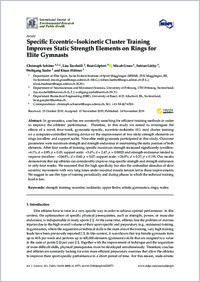Specific eccentric–isokinetic cluster training improves static strength elements on rings for elite gymnasts
- Schärer, Christoph Department of Elite Sport, Swiss Federal Institute of Sport Magglingen (SFISM), Switzerland - Department of Neurosciences and Movement Sciences, University of Fribourg, Switzerland
- Tacchelli, Lisa Department of Neurosciences and Movement Sciences, University of Fribourg, Switzerland
- Göpfert, Beat Department Biomedical Engineering (DBE), University of Basel, Switzerland
- Gross, Micah Department of Elite Sport, Swiss Federal Institute of Sport Magglingen (SFISM), Switzerland
- Lüthy, Fabian Department of Elite Sport, Swiss Federal Institute of Sport Magglingen (SFISM), Switzerland
- Taube, Wolfgang Department of Neurosciences and Movement Sciences, University of Fribourg, Switzerland
- Hübner, Klaus Department of Elite Sport, Swiss Federal Institute of Sport Magglingen (SFISM), Switzerland
-
2019
Published in:
- International Journal of Environmental Research and Public Health. - 2019, vol. 16, no. 22, p. 4571
English
In gymnastics, coaches are constantly searching for efficient training methods in order to improve the athletes’ performance. Therefore, in this study we aimed to investigate the effects of a novel, four-week, gymnastic-specific, eccentric–isokinetic (0.1 m/s) cluster training on a computer-controlled training device on the improvement of two static strength elements on rings (swallow and support scale). Nine elite male gymnasts participated in this study. Outcome parameters were maximum strength and strength endurance in maintaining the static position of both elements. After four weeks of training, specific maximum strength increased significantly (swallow: +4.1%; d = 0.85; p = 0.01; support scale: +3.6%; d = 2.47; p = 0.0002) and strength endurance tended to improve (swallow: +104.8%; d = 0.60; p = 0.07; support scale: +26.8%; d = 0.27; p = 0.19). Our results demonstrate that top athletes can considerably improve ring-specific strength and strength endurance in only four weeks. We assumed that the high specificity but also the unfamiliar stimulus of slow eccentric movements with very long times under maximal muscle tension led to these improvements. We suggest to use this type of training periodically and during phases in which the technical training load is low
- Faculty
- Faculté des sciences et de médecine
- Department
- Département de Médecine
- Language
-
- English
- Classification
- Sports sciences
- License
-
License undefined
- Identifiers
-
- RERO DOC 328020
- DOI 10.3390/ijerph16224571
- Persistent URL
- https://folia.unifr.ch/unifr/documents/308354
Statistics
Document views: 158
File downloads:
- pdf: 304
